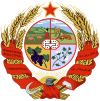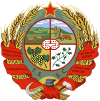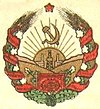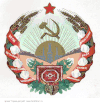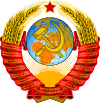|
Emblem of the Turkmen Soviet Socialist Republic
The Emblem of the Turkmen Soviet Socialist Republic was adopted on 2 March 1937 by the government of the Turkmen Soviet Socialist Republic. The coat of arms is based on the coat of arms of the Soviet Union. It shows symbols of agriculture (cotton, wheat and grapes) and heavy industry (oil derrick and pipeline), as well as a symbol of the Turkmen people, a rug. The rising Sun stands for the future of the Turkmen nation, the red star as well as the hammer and sickle for the victory of Communism and the "world-wide socialist community of states". The banner bears the Soviet Union state motto ("Workers of the world, unite!") in both the Russian and Turkmen languages. In Turkmen, it is "Әxли юртлариң пролетарлары, бирлешиң!" (in the current Turkmen Latin script: "Ähli ýurtlaryň proletarlary, birleşiň!"). Later version of the coat of arms had acronym "TSSR" between red star, above, and hammer and sickle, below.[1] The emblem was changed in 1992 to the present Emblem of Turkmenistan, which however, retains some of the parts of the Soviet one. In this case, wheat, cotton and the Turkmen rug. HistoryFirst versionFor some time after its formation the Turkmen SSR had no state symbols. On August 9, 1925, the Turkmen Central Executive Committee informed the Central Executive Committee of the Union that Turkmenistan was still using the coat of arms of the USSR. On May 26, 1926, the Turkmen CEC established a commission for the development of the coat of arms, and on August 18, 1926, the Central Executive Committee of the TSSR decided to adopt the design of the emblem by Andrei Andreevich Karelin as the basis for the state emblem of the Turkmen SSR. The design was as following :
At the third session of the Central Executive Committee of the USSR (October 1-6, 1926), the emblem was approved. First revisionThe Second All-Turkmen Congress of Soviets from 26 March until 3 April 1927 adopted the Constitution of the Soviet Socialist Republic of Turkmenistan, according to which the arms were slightly modified:
In the Constitution of the Turkmen SSR that was created on October 6, 1926 and approved by the 2nd All-Turkmen Congress of Soviets on April 1, 1927, the coat of arms is described in Article 82:
Second revisionBy the decree of the Central Executive Committee of the USSR on 1927 the inscriptions on the coat of arms were changed from Arabic letters to Latin letters. the motto in the Turkmen language on it should be: "ВIRLEŞIꞐ, ВYTIIN JER JYZINIꞐ JOOQSЬLLARЬ!". There was another addition in the lower part of the coat of arms between the shield and the frame, which is the abbreviation "T.S.Ş.Ç." for Tyrkmenistaan Sosьjaaʟ Şuuraaʟar Çemhuurjeti. This change itself is earlier than the official transition from the Arabic letters to Latin letters. Only in 1928, with the approval January 3, 1928 by the Central Executive Committee of the Turkmen SSR the Arabic alphabet was replaced by the Latin alphabet. The final transition to the Latin letters in all official spheres was carried out by May 1929. Second version At the end of 1936, according to the draft of the new Constitution, the state emblem consisted of an image of a golden sickle and a hammer, a red star against the background of the rising sun, framed with a wreath of blossoming cotton and ears, and a red ribbon with the inscription: "Workers of all countries, unite!" - in Turkmen and Russian. The author of the project was the artist Alexander Pavlovich Vladychuk. The project of the emblem was discussed by the general public and was not recognized as successful. So, Professor A. Potseluevsky believed that "the design of the state emblem would be quite consistent with its purpose, if Turkmenistan was only an agrarian country. Meanwhile, the Turkmen SSR is an industrial-agrarian country, and therefore it is necessary to introduce some emblem of the industry in its arms." This was not just a proposal, but an expression of pride in the successes of socialist construction of a previously backward people. Potseluevsky suggested introducing an element reflecting and developing the industry. As such, an emblem to take factory buildings [2][3] The Extraordinary VI All-Turkmen Congress of Soviets on March 2, 1937, adopts the new Constitution, in 121 of which the emblem is described:[2]
First revisionIn 1940, the letters Turkmen language was converted into Cyrillic, according to the law of May 14, 1940, adopted at the IV session of the Supreme Soviet of the USSR. According to the Decree of the Presidium of the Supreme Council of Turkmenistan dated April 28, 1941, the text of the inscriptions on the arms was written according to the new alphabet.[3][4] The inscription of the motto in the Turkmen Cyrillic alphabet: "БҮТИН ЕР ЙҮЗИНИҢ ПРОЛЕТАРЛАРЫ, БИРЛЕШИҢ" Second revisionAfter the creation of a new coat of arms of the USSR in 1946, the translation of the motto into the Turkmen language was clarified. The translation of the motto was changed as "ӘХЛИ ЮРТЛАРЫҢ ПРОЛЕТАРЛАРЫ, БИРЛЕШИҢ!". Before that, the translation of the motto in the Turkmen language sounded like "Proletarians of the whole earth, unite!". According to the commission created by the Presidium of the USSR Supreme Council in 1937, the translation of the previous slogan, which was made in the 1930s was inaccurate. Third revisionAfter the adoption of the all-Union Constitution in 1977, the new Constitution of the Turkmen SSR was adopted at the extraordinary, 9th session of the Supreme Soviet of the Turkmen SSR, on the ninth convocation on April 13, 1978. According to the new constitution, a new description of the arms was given in Article 168:
The small change of the coat of arms was the addition of the abbreviated name of the country under the star, the amount of sunlight decreased, and the change of the carpet pattern. See alsoReferences
External links
|
||||||||||||||||||||||||||||

